RENAULT SCENIC 2016 J95 / 3.G Workshop Manual
Manufacturer: RENAULT, Model Year: 2016, Model line: SCENIC, Model: RENAULT SCENIC 2016 J95 / 3.GPages: 270, PDF Size: 2.66 MB
Page 51 of 270
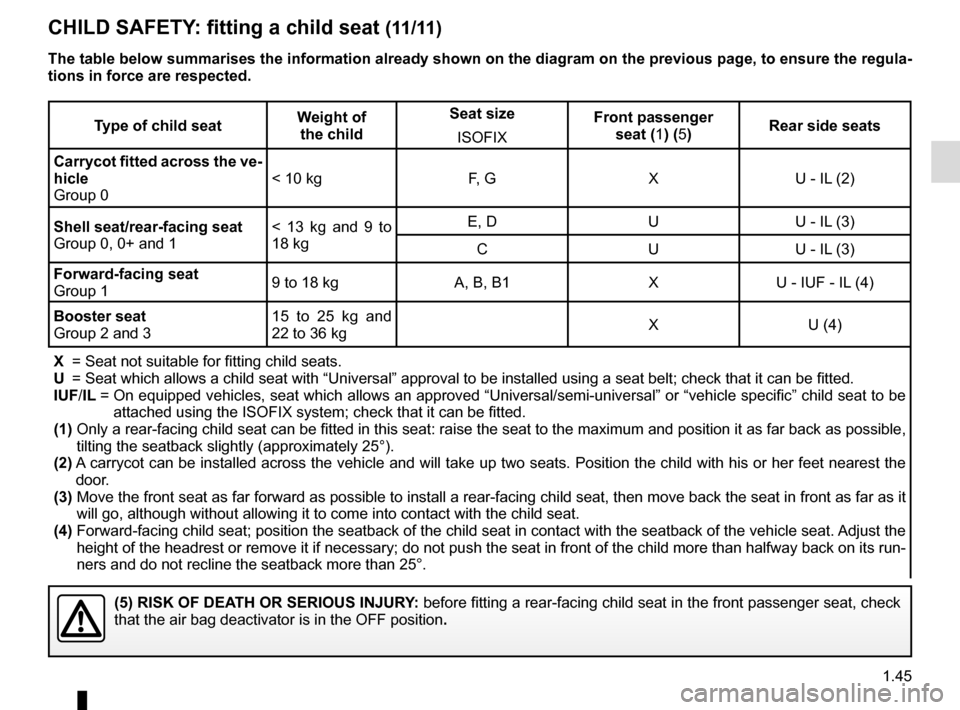
1.45
Type of child seatWeight of
the child Seat size
ISOFIX Front passenger
seat (1) (5) Rear side seats
Carrycot fitted across the ve-
hicle
Group 0 < 10 kg
F, GXU - IL (2)
Shell seat/rear-facing seat
Group 0, 0+ and 1 < 13 kg and 9 to
18 kgE, D
UU - IL (3)
C UU - IL (3)
Forward-facing seat
Group 1 9 to 18 kg
A, B, B1 XU - IUF - IL (4)
Booster seat
Group 2 and 3 15 to 25 kg and
22 to 36 kg
X
U (4)
X = Seat not suitable for fitting child seats.
U = Seat which allows a child seat with “Universal” approval to be ins\
talled using a seat belt; check that it can be fitted.
IUF/IL = On equipped vehicles, seat which allows an approved “Universal/semi-u\
niversal” or “vehicle specific” child seat to be
attached using the ISOFIX system; check that it can be fitted.
(1) Only a rear-facing child seat can be fitted in this seat: raise the seat\
to the maximum and position it as far back as possible ,
tilting the seatback slightly (approximately 25°).
(2) A carrycot can be installed across the vehicle and will take up two seats\
. Position the child with his or her feet nearest the
door.
(3) Move the front seat as far forward as possible to install a rear-facing \
child seat, then move back the seat in front as far as it
will go, although without allowing it to come into contact with the chil\
d seat.
(4) Forward-facing child seat; position the seatback of the child seat in co\
ntact with the seatback of the vehicle seat. Adjust the
height of the headrest or remove it if necessary; do not push the seat i\
n front of the child more than halfway back on its run-
ners and do not recline the seatback more than 25°.
(5) RISK OF DEATH OR SERIOUS INJURY: before fitting a rear-facing child seat in the front passenger seat, ch\
eck
that the air bag deactivator is in the OFF position .
The table below summarises the information already shown on the diagram \
on the previous page, to ensure the regula-
tions in force are respected.
CHILD SAFETY: fitting a child seat (11/11)
Page 52 of 270
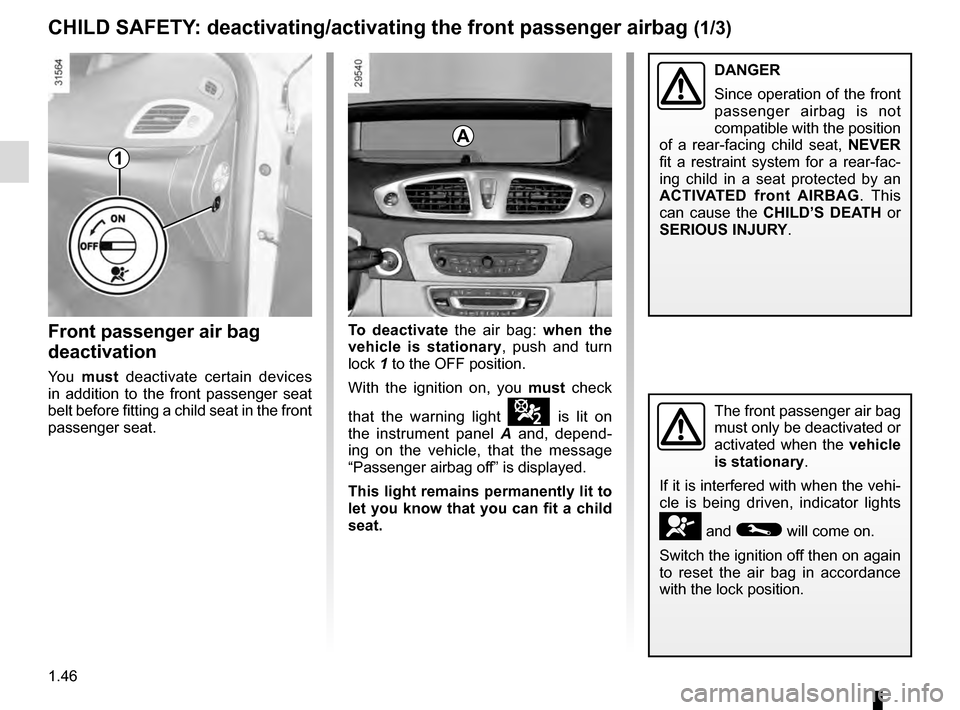
1.46
Front passenger air bag
deactivation
You must deactivate certain devices
in addition to the front passenger seat
belt before fitting a child seat in the front
passenger seat.
The front passenger air bag
must only be deactivated or
activated when the vehicle
is stationary.
If it is interfered with when the vehi-
cle is being driven, indicator lights
å and © will come on.
Switch the ignition off then on again
to reset the air bag in accordance
with the lock position.
CHILD SAFETY: deactivating/activating the front passenger airbag (1/3)
To deactivate the air bag: when the
vehicle is stationary, push and turn
lock 1 to the OFF position.
With the ignition on, you must check
that the warning light
¹ is lit on
the instrument panel A and, depend-
ing on the vehicle, that the message
“Passenger airbag off” is displayed.
This light remains permanently lit to
let you know that you can fit a child
seat.
1
A
DANGER
Since operation of the front
passenger airbag is not
compatible with the position
of a rear-facing child seat, NEVER
fit a restraint system for a rear-fac-
ing child in a seat protected by an
ACTIVATED front AIRBAG . This
can cause the CHILD’S DEATH or
SERIOUS INJURY.
Page 53 of 270
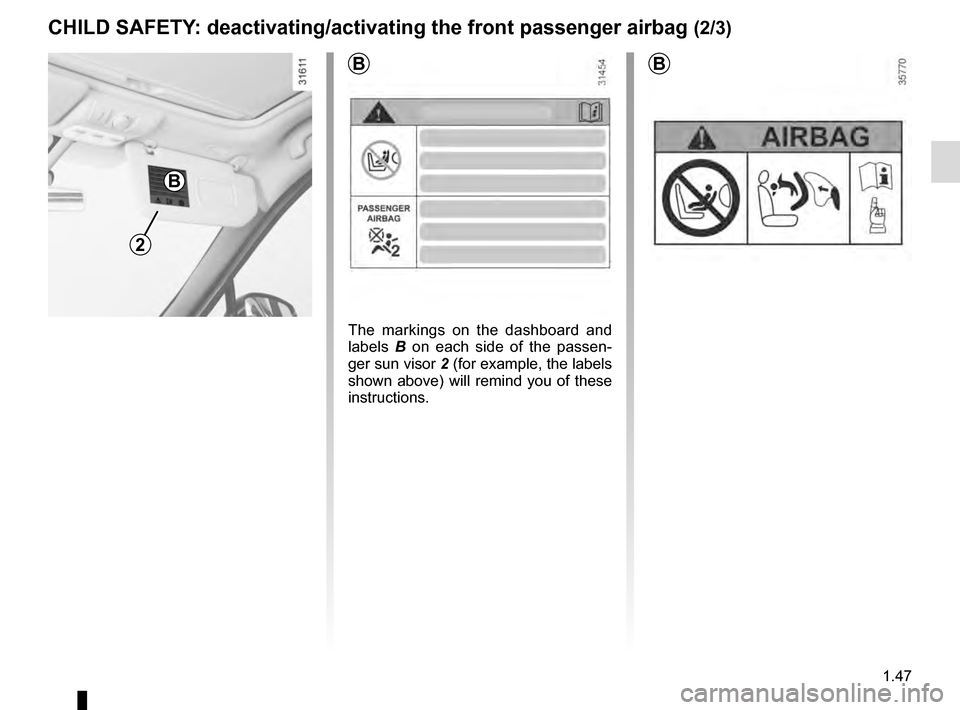
1.47
2
B
B
CHILD SAFETY: deactivating/activating the front passenger airbag (2/3)
B
The markings on the dashboard and
labels B on each side of the passen-
ger sun visor 2 (for example, the labels
shown above) will remind you of these
instructions.
Page 54 of 270
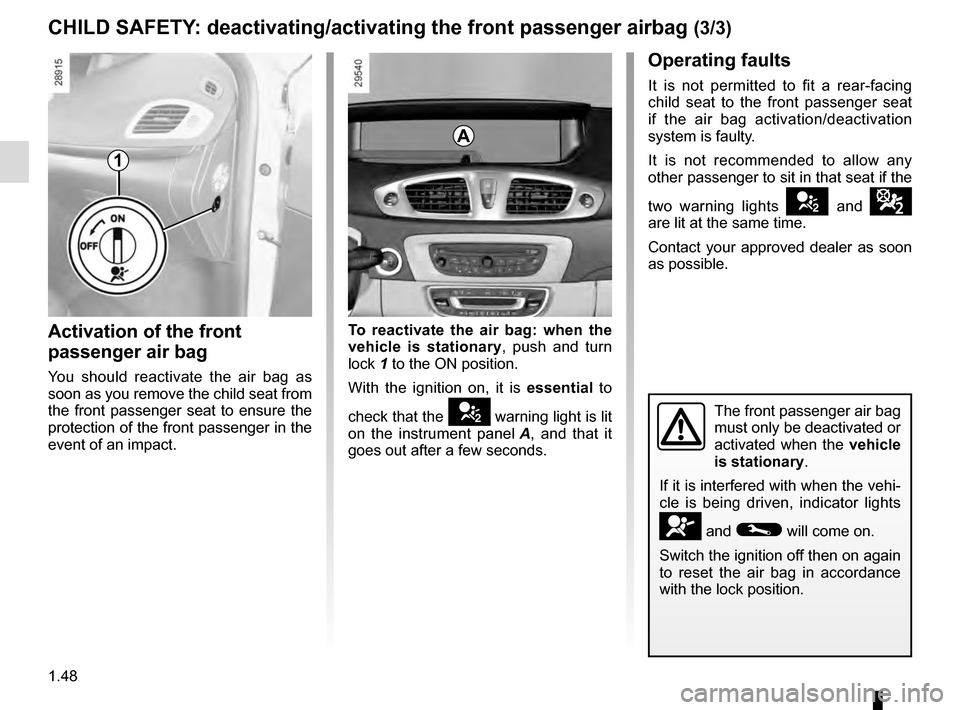
1.48
CHILD SAFETY: deactivating/activating the front passenger airbag (3/3)
1
Operating faults
It is not permitted to fit a rear-facing
child seat to the front passenger seat
if the air bag activation/deactivation
system is faulty.
It is not recommended to allow any
other passenger to sit in that seat if the
two warning lights
› and ¹
are lit at the same time.
Contact your approved dealer as soon
as possible.
Activation of the front
passenger air bag
You should reactivate the air bag as
soon as you remove the child seat from
the front passenger seat to ensure the
protection of the front passenger in the
event of an impact. To reactivate the air bag: when the
vehicle is stationary, push and turn
lock 1 to the ON position.
With the ignition on, it is
essential to
check that the
› warning light is lit
on the instrument panel A, and that it
goes out after a few seconds.The front passenger air bag
must only be deactivated or
activated when the vehicle
is stationary.
If it is interfered with when the vehi-
cle is being driven, indicator lights
å and © will come on.
Switch the ignition off then on again
to reset the air bag in accordance
with the lock position.
A
Page 55 of 270
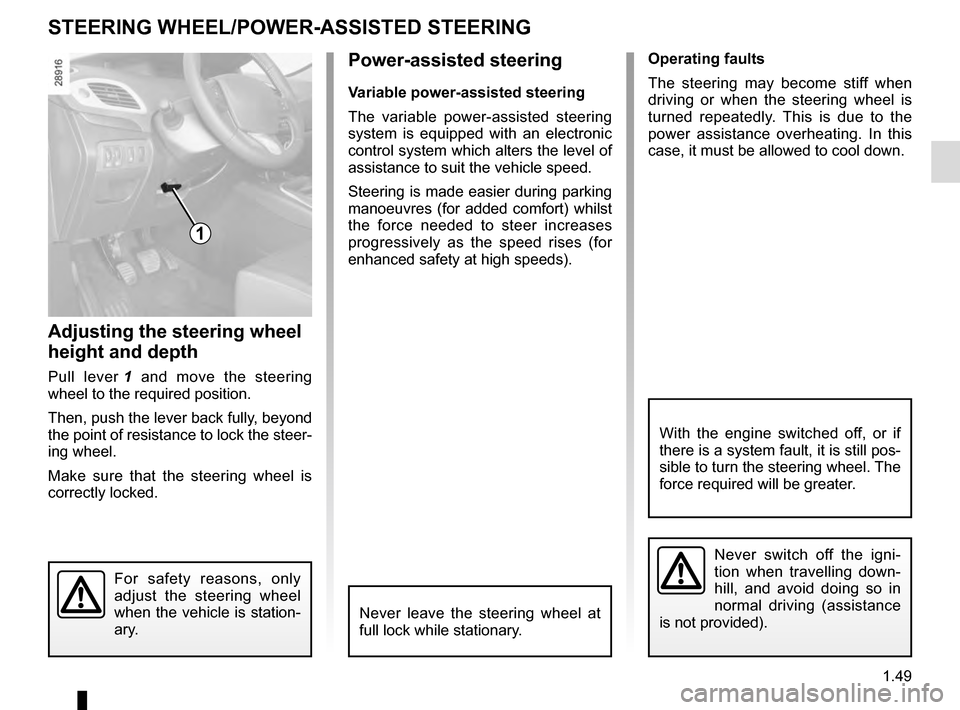
1.49
STEERING WHEEL/POWER-ASSISTED STEERING
Operating faults
The steering may become stiff when
driving or when the steering wheel is
turned repeatedly. This is due to the
power assistance overheating. In this
case, it must be allowed to cool down.Power-assisted steering
Variable power-assisted steering
The variable power-assisted steering
system is equipped with an electronic
control system which alters the level of
assistance to suit the vehicle speed.
Steering is made easier during parking
manoeuvres (for added comfort) whilst
the force needed to steer increases
progressively as the speed rises (for
enhanced safety at high speeds).
Adjusting the steering wheel
height and depth
Pull lever 1 and move the steering
wheel to the required position.
Then, push the lever back fully, beyond
the point of resistance to lock the steer-
ing wheel.
Make sure that the steering wheel is
correctly locked.
For safety reasons, only
adjust the steering wheel
when the vehicle is station-
ary.
Never leave the steering wheel at
full lock while stationary.
Never switch off the igni-
tion when travelling down-
hill, and avoid doing so in
normal driving (assistance
is not provided).
With the engine switched off, or if
there is a system fault, it is still pos-
sible to turn the steering wheel. The
force required will be greater.
1
Page 56 of 270
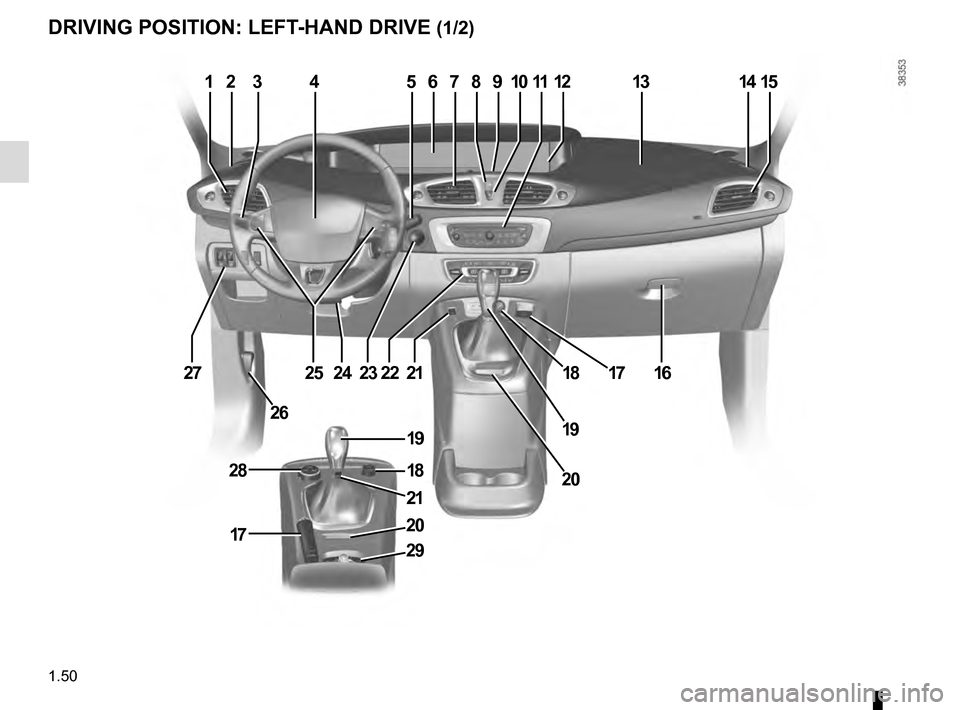
1.50
DRIVING POSITION: LEFT-HAND DRIVE (1/2)
234567810111314
16
20
2223
26
2725
12
24
28
17
21
29
21
18
1817
1919
20
9115
Page 57 of 270
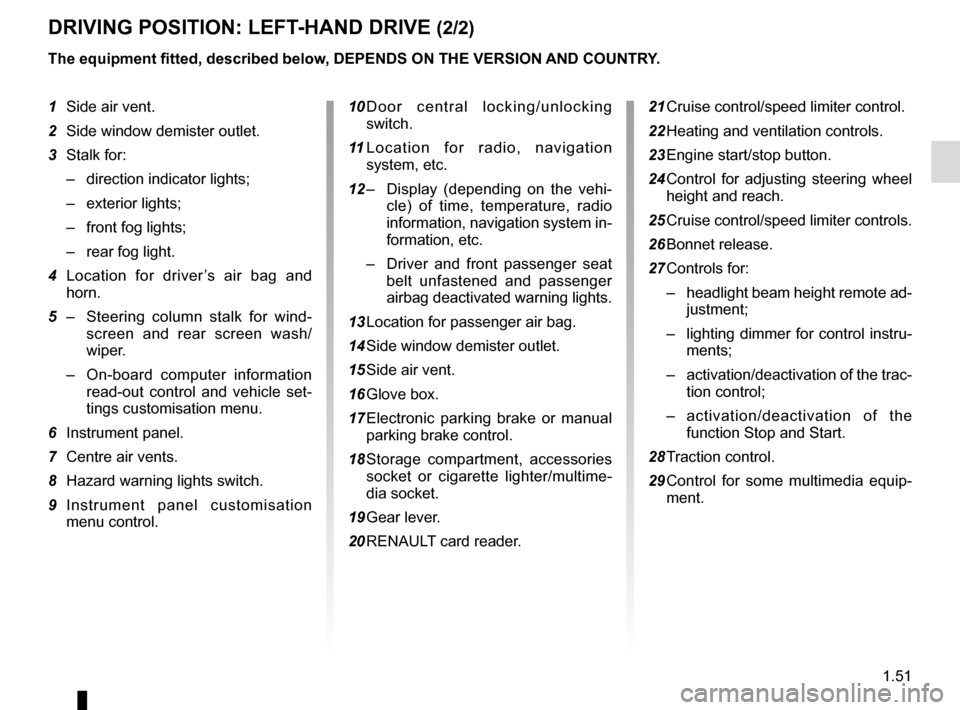
1.51
DRIVING POSITION: LEFT-HAND DRIVE (2/2)
1 Side air vent.
2 Side window demister outlet.
3 Stalk for:
– direction indicator lights;
– exterior lights;
– front fog lights;
– rear fog light.
4 Location for driver’s air bag and horn.
5 – Steering column stalk for wind-
screen and rear screen wash/
wiper.
– On-board computer information
read-out control and vehicle set-
tings customisation menu.
6 Instrument panel.
7 Centre air vents.
8 Hazard warning lights switch.
9 Instrument panel customisation menu control.
The equipment fitted, described below, DEPENDS ON THE VERSION AND COUNTRY.
21 Cruise control/speed limiter control.
22 Heating and ventilation controls.
23 Engine start/stop button.
24 Control for adjusting steering wheel height and reach.
25 Cruise control/speed limiter controls.
26 Bonnet release.
27 Controls for: – headlight beam height remote ad-
justment;
– lighting dimmer for control instru-
ments;
– activation/deactivation of the trac-
tion control;
– activation/deactivation of the
function Stop and Start.
28 Traction control.
29 Control for some multimedia equip- ment.
10 Door central locking/unlocking
switch.
11 Location for radio, navigation
system, etc.
12 – Display (depending on the vehi-
cle) of time, temperature, radio
information, navigation system in-
formation, etc.
– Driver and front passenger seat
belt unfastened and passenger
airbag deactivated warning lights.
13 Location for passenger air bag.
14 Side window demister outlet.
15 Side air vent.
16 Glove box.
17 Electronic parking brake or manual parking brake control.
18 Storage compartment, accessories socket or cigarette lighter/multime-
dia socket.
19 Gear lever.
20 RENAULT card reader.
Page 58 of 270
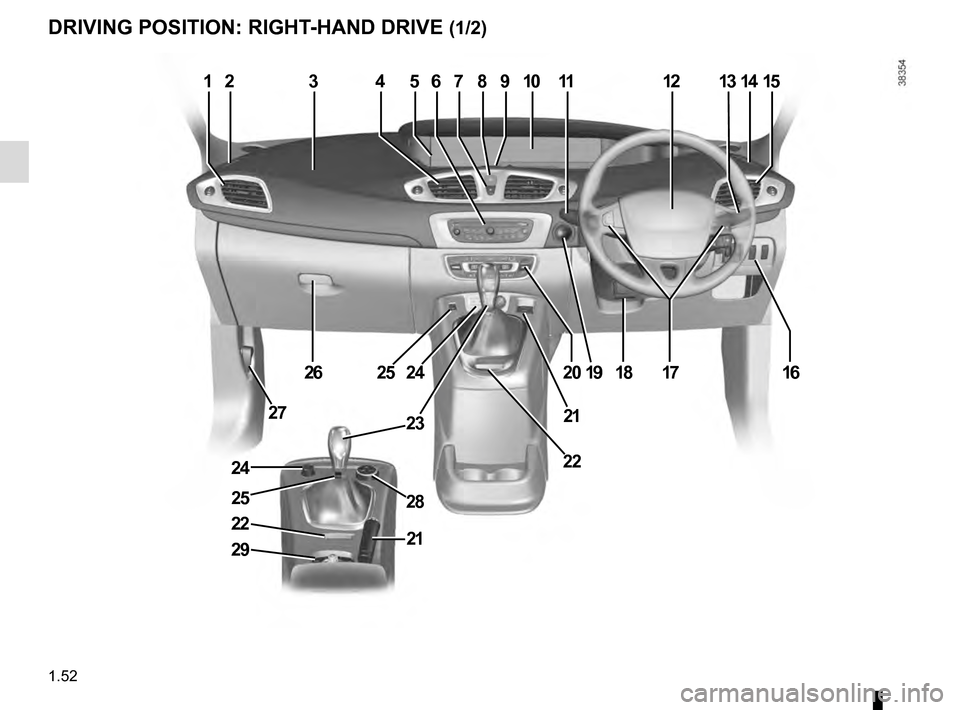
1.52
DRIVING POSITION: RIGHT-HAND DRIVE (1/2)
234678111014
181719
21
22
242526
27
51213
16
9
20
24
2129
22
2825
23
115
Page 59 of 270
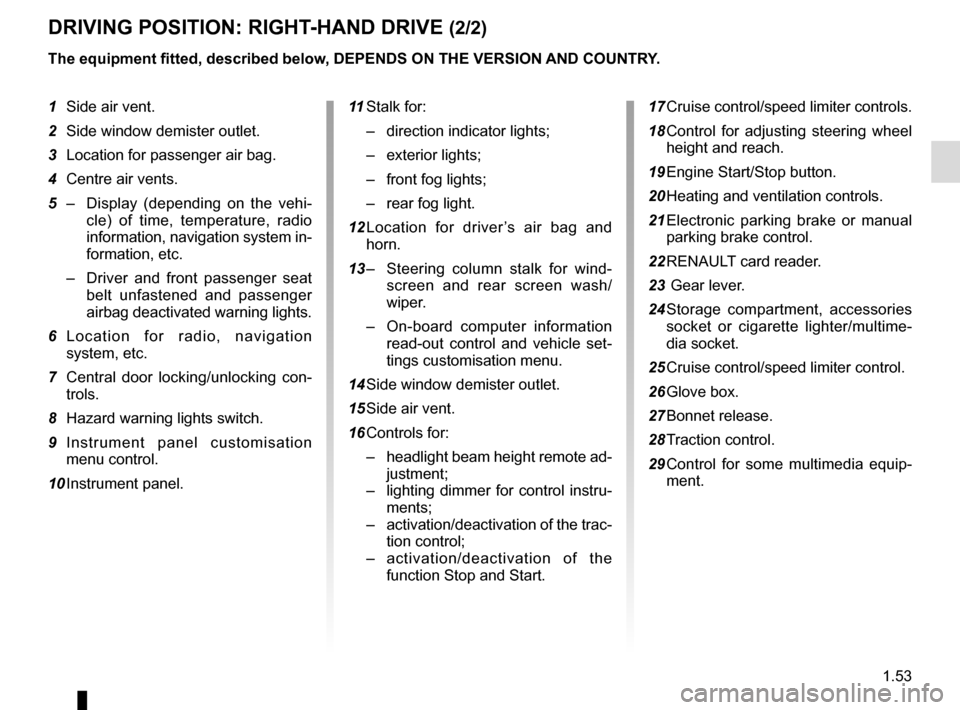
1.53
DRIVING POSITION: RIGHT-HAND DRIVE (2/2)
The equipment fitted, described below, DEPENDS ON THE VERSION AND COUNTRY.
1 Side air vent.
2 Side window demister outlet.
3 Location for passenger air bag.
4 Centre air vents.
5 – Display (depending on the vehi-
cle) of time, temperature, radio
information, navigation system in-
formation, etc.
– Driver and front passenger seat
belt unfastened and passenger
airbag deactivated warning lights.
6 Location for radio, navigation system, etc.
7 Central door locking/unlocking con- trols.
8 Hazard warning lights switch.
9 Instrument panel customisation menu control.
10 Instrument panel.
17 Cruise control/speed limiter controls.
18 Control for adjusting steering wheel height and reach.
19 Engine Start/Stop button.
20 Heating and ventilation controls.
21 Electronic parking brake or manual parking brake control.
22 RENAULT card reader.
23 Gear lever.
24 Storage compartment, accessories socket or cigarette lighter/multime-
dia socket.
25 Cruise control/speed limiter control.
26 Glove box.
27 Bonnet release.
28 Traction control.
29 Control for some multimedia equip- ment.
11
Stalk for:
– direction indicator lights;
– exterior lights;
– front fog lights;
– rear fog light.
12 Location for driver’s air bag and horn.
13 – Steering column stalk for wind-
screen and rear screen wash/
wiper.
– On-board computer information
read-out control and vehicle set-
tings customisation menu.
14 Side window demister outlet.
15 Side air vent.
16 Controls for: – headlight beam height remote ad-
justment;
– lighting dimmer for control instru-
ments;
– activation/deactivation of the trac-
tion control;
– activation/deactivation of the
function Stop and Start.
Page 60 of 270
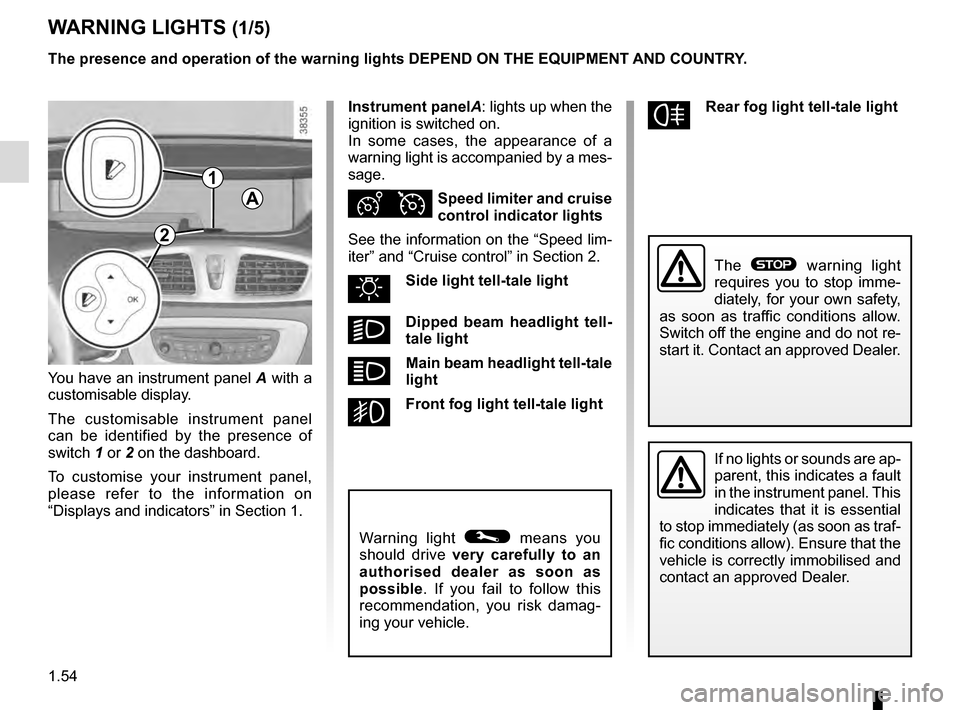
1.54
WARNING LIGHTS (1/5)
If no lights or sounds are ap-
parent, this indicates a fault
in the instrument panel. This
indicates that it is essential
to stop immediately (as soon as traf-
fic conditions allow). Ensure that the
vehicle is correctly immobilised and
contact an approved Dealer.
Warning light © means you
should drive very carefully to an
authorised dealer as soon as
possible. If you fail to follow this
recommendation, you risk damag-
ing your vehicle.
The ® warning light
requires you to stop imme-
diately, for your own safety,
as soon as traffic conditions allow.
Switch off the engine and do not re-
start it. Contact an approved Dealer.
Instrument panelA: lights up when the
ignition is switched on.
In some cases, the appearance of a
warning light is accompanied by a mes-
sage.
ÐÏSpeed limiter and cruise
control indicator lights
See the information on the “Speed lim-
iter” and “Cruise control” in Section 2.
uSide light tell-tale light
kDipped beam headlight tell-
tale light
áMain beam headlight tell-tale
light
gFront fog light tell-tale light
You have an instrument panel
A with a
customisable display.
The customisable instrument panel
can be identified by the presence of
switch 1 or 2 on the dashboard.
To customise your instrument panel,
please refer to the information on
“Displays and indicators” in Section 1.
fRear fog light tell-tale light
The presence and operation of the warning lights DEPEND ON THE EQUIPMENT\
AND COUNTRY.
A
2
1